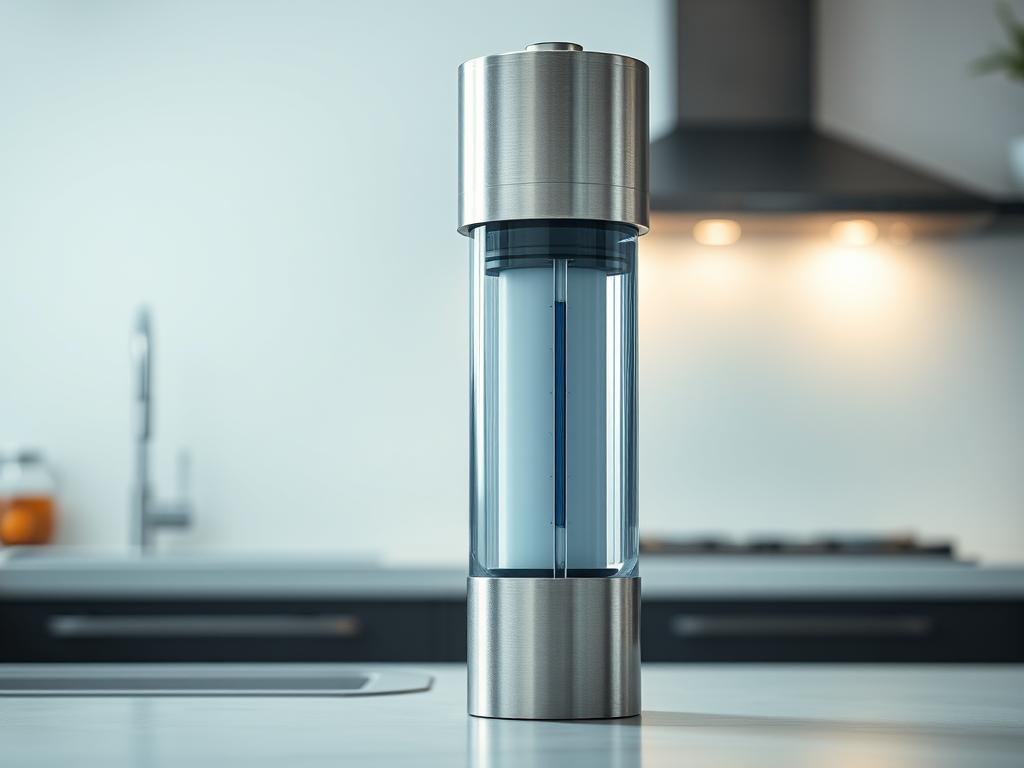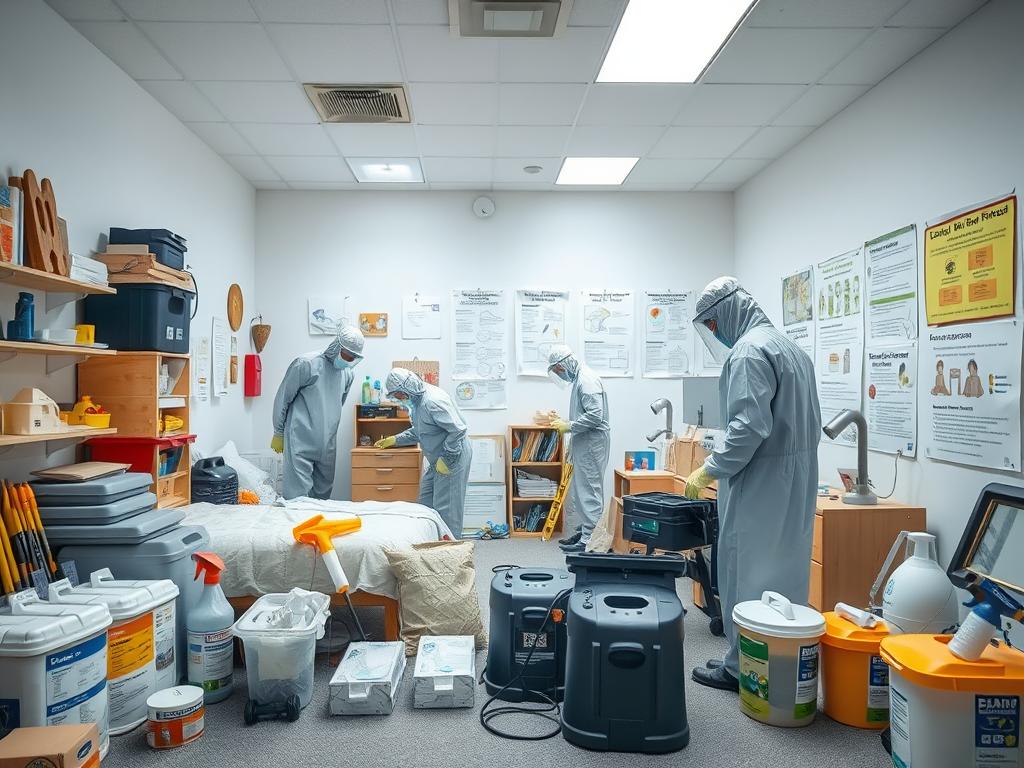Did you know 9 million homes in the U.S. get water through lead pipes? This is a big problem. In Texas, about 380,000 homes are at risk, affecting many families.
Lead pipes can make our water toxic. This is especially bad for babies and young kids. They can get sick from even a little bit of lead.
Even though rules have changed, old homes still have lead pipes. The EPA says there should be no lead in our water. So, how do we keep our families safe?
It’s important to know about lead pipes and how to protect our water. This guide will help you make sure your water is safe for your family.
Key Takeaways
- Lead pipes are a common source of lead contamination in drinking water
- There is no safe level of lead exposure, especially for children and pregnant women
- Homes built before the 1980s are at higher risk of having lead plumbing
- Water testing and certified filters can help reduce lead exposure
- Community awareness and action are crucial in addressing lead pipe issues
Understanding Lead Pipes and Their Risks
Lead pipes were common in homes before 1970. They can make water unsafe to drink. This is a big risk for families in the U.S.
What Are Lead Pipes?
Lead pipes are made from the toxic metal lead. They were used until the 1970s. Homes built before then might have them, but newer ones don’t.
How Lead Enters Drinking Water
Lead gets into water when it sits in lead pipes. The pipe’s condition, water temperature, and hardness matter. Water companies treat water to lower lead levels, but illegal solder can still cause problems.
Health Effects of Lead Exposure
Lead is very harmful, especially for kids and pregnant women. The EPA says there’s no safe level of lead for young children. Low levels can still hurt health, affecting the brain, kidneys, and heart.
To keep your family safe, test your water for lead. Flushing taps for 10 minutes after work and clearing water can help. Remember, the part of the pipe from the main to your stop valve is the water company’s. The part from your stop valve to your home is yours.
Historical Use of Lead Pipes in the United States
Lead pipes have been used in the U.S. since the late 1800s. By 1900, over 70% of big cities used them. Lead pipes were chosen for their strength and long life.
Timeline of Lead Pipe Installation
Lead pipe use reached its peak from 1900 to 1940. Cities like New York and Chicago used them. The Lead Industries Association helped promote their use.

Regulations and Bans on Lead Pipes
As health risks of lead became known, laws were made. In 1986, Congress banned non-‘lead-free’ materials in public water systems. The EPA’s 1991 Lead and Copper Rule set a limit of 15 parts per billion in drinking water.
- The EPA’s goal for lead in drinking water is zero
- Lead pipe replacement costs are estimated between $28-$47 billion
- Recent federal investment allocates $10 billion for lead pipe removal
Identifying Lead Pipes in Your Home
Lead pipes are a big risk for water contamination. Over 9 million lead service lines are in the U.S. It’s key to know if your home has them. The U.S. Environmental Protection Agency wants to remove most lead pipes in 10 years.
How to Check for Lead Pipes
To find lead pipes, look at the water line coming into your home. It’s usually in the basement or crawl space. Look for a gray pipe that can be scratched with a key. A magnet won’t stick to lead pipes.
Signs of Lead Pipe Use
Here are signs you might have lead pipes:
- Water that looks cloudy when first drawn
- A metallic taste in your water
- Stains on dishes or laundry
- Low water pressure
Homes built before 1986 might have lead pipes or solder. If you think you have lead pipes, test your water. There’s no safe level of lead, and even small amounts can harm health. Keep your family safe by finding and fixing lead pipes fast.
Testing Drinking Water for Lead
Keeping your drinking water safe is very important for your family’s health. Lead in water is a big risk, especially in older homes. The Environmental Protection Agency (EPA) says up to 20% of lead exposure comes from water.
Let’s look at how to test your water for lead.
Home Testing Kits: Pros and Cons
Home testing kits are a fast way to check for lead in your water. They are cheap and give quick results. But, they might not be as accurate as lab tests.
These kits can spot lead but can’t show exact levels. This makes it hard to know if your water is safe, according to the EPA’s standards.
Professional Water Testing Services
For exact results, use professional water testing services. State-certified labs can find lead as low as 1 part per billion. These tests are more reliable and can find other harmful substances too.
It’s crucial for well water, which should be tested every few years. Sadly, about 60% of well owners don’t test their water often.
Water sampling results can change with the time of day, season, and flow. Testing regularly is essential to keep your water safe. If you think your water might have lead, get it tested by a pro.
Assessing the Safety of Your Drinking Water
It’s very important to have safe drinking water at home. The U.S. Environmental Protection Agency (EPA) makes sure water systems give out yearly reports. These reports tell you if your water is safe and if there are any problems.
Understanding Water Quality Reports
Water quality reports show what’s in your water. They tell you about lead levels and other dangers. The EPA wants lead levels to be zero in drinking water.
If lead levels are too high, the water company must tell everyone and fix the problem.
Common Contaminants besides Lead
Lead is a big worry, but other things can also harm your water. These include:
- Copper
- Bacteria
- Nitrates
- Arsenic
- Pesticides
The EPA updated its rules in 2021. Now, water companies must find out if your home has lead pipes. Homes built after the late 1980s are less likely to have lead pipes. But, older homes might have a problem.
To keep your family safe, think about using NSF International certified water filters. They can help lower lead levels in your water. Always follow the maker’s instructions to keep your water safe.
Mitigating Risks: Treatment Options
Keeping your family safe from lead in water is very important. The EPA says using certified filters can help. This makes sure your water is safe to drink.
Filters and Their Effectiveness
Water filters are a big help against lead pipes. You can use pitcher filters, faucet-mounted ones, or whole-house systems. Make sure they are certified by NSF International for lead removal.
Don’t forget to change the filters often. This keeps them working well.

Point-of-Use Treatment Systems
Point-of-use systems give extra protection. They treat water at specific taps or appliances. This adds an extra layer of safety.
Reverse osmosis systems are very good at removing lead from water.
The Bipartisan Infrastructure Law has more money for lead cleanup. It gives $15 billion to the EPA for replacing lead service lines. This helps communities that need it most, with grants and loans that don’t have to be paid back.
To keep your family safe:
- Clean tap faucet screens often
- Let water run for a few minutes before drinking
- Use cold water for cooking and drinking
Remember, there’s no safe amount of lead in water. Take steps to protect your family’s health. Use these treatment options and stay updated on your water quality.
Importance of Routine Maintenance
Regular maintenance is key to keeping families safe from lead in water. Lead pipes in older homes are a big risk. It’s important for homeowners to know how to handle this risk.
Plumbing Inspections for Lead Pipes
Checking your plumbing regularly is crucial. It helps find lead sources in your water system. Public water utilities must find and replace lead lines. But homeowners should also act:
- Schedule annual inspections with a licensed plumber
- Check for signs of corrosion or discoloration in pipes
- Use at-home lead water test kits for regular monitoring
Flushing Your Pipes
Flushing your pipes can lower lead exposure. Residents in some cities should follow specific flushing instructions. Here are some tips:
- Run cold water for a few minutes before use
- Avoid using hot water for drinking or cooking, as it increases lead dissolution
- Clean faucet aerators monthly to remove accumulated lead particles
By following these maintenance tips, you can lower the risk of lead in your water. Even though Columbus water plants say there’s no lead, it’s still important to stay careful. This keeps your water safe at home.
Community Action and Advocacy
Fighting for safe drinking water needs everyone’s help. Millions of lead pipes are still in use in the U.S. We must raise awareness and work together to solve this problem.
Importance of Reporting and Awareness
Telling authorities about suspected lead contamination is very important. The EPA says 9 to 12 million lead pipes are still around, which is dangerous. People should keep up with local water quality reports and tell their neighbors.
Using community meetings and social media can help spread the word about lead dangers.

Engaging Local Government
It’s important to push for better water systems. The EPA is giving $15 billion over five years to replace lead pipes. Here’s how you can help:
- Attend city council meetings
- Write letters to elected officials
- Organize petition drives
- Form neighborhood action groups
Places like Newark have made progress by working together. They replaced 70% of lead pipes with community funds. By joining forces, we can make sure everyone has safe drinking water.
Legal and Financial Assistance
Fixing lead pipes and water contamination costs a lot. But, there’s help out there. The U.S. government knows this is urgent and has given a lot of money to solve it.
Resources for Lead Pipe Replacement
The Bipartisan Infrastructure Law has $15 billion for lead pipe replacement. This money helps the Environmental Protection Agency replace all lead pipes in 10 years. There are programs that give financial help:
- Drinking Water State Revolving Fund: Offers low-interest loans to states
- Michigan’s Lead Service Line Replacement Fund: Requires water quality checks
- City-specific programs: Many big cities help with replacement costs
Understanding Liability
Liability for lead contamination is tricky. The EPA makes rules for lead in water. Homeowners might have to fix lead pipes on their property. It’s important to know local laws and help your community.
Replacing lead pipes is more than just money. It’s about keeping your family safe. Studies show it’s worth it, with big health and economic gains.
Future of Lead Pipes and Water Safety
The U.S. is on the verge of a big change in safe drinking water. In October 2024, the EPA released a new rule to fight lead contamination. This rule aims to remove nearly all lead water pipes in the next decade.
Innovations in Plumbing Technology
New plumbing tech is making water safer. Materials and methods are being made to replace the 9 million lead pipes in the U.S. These new options are durable and lead-free, ensuring safe drinking water for millions.
Steps Toward Lead-Free Water Infrastructure
The move to lead-free water is gaining speed. The Bipartisan Infrastructure Law has set aside $15 billion for lead pipe removal. This is a big step for the 10 million lead pipes serving 22 million people.
States like Florida and Illinois, with over 1 million lead pipes each, will get a lot of funding. This effort aims to stop lead exposure, which harms kids’ brains and heart health.
Cities and states are working hard to make these changes. The future of water safety looks bright. Replacing lead pipes and improving water treatment tech will make the U.S. water system safer.
FAQ
Q: What are the main health risks associated with lead pipes in drinking water?
A: Lead pipes in drinking water can harm your health. They can cause delays in children’s development and affect the brain. Pregnant women and young kids are especially at risk.
Q: How can I tell if my home has lead pipes?
A: Look for dull gray pipes that can be scratched with a key. Lead pipes will show a shiny silver color when scratched. The best way to know for sure is to have a plumber check or test your water for lead.
Q: Are home water testing kits reliable for detecting lead?
A: Home testing kits can show if there’s lead, but they’re not always right. For sure results, get your water tested at a lab. This is especially true if you think your water might have lead.
Q: What types of water filters are most effective at removing lead?
A: Look for filters that remove lead, like reverse osmosis systems. Make sure they’re certified by NSF International. They should meet NSF/ANSI Standard 53 for lead reduction.
Q: How often should I have my water tested for lead?
A: Test your water for lead every year if you live in an old home or area with lead pipes. If your pipes are new, test every 3-5 years. Always test right away if your water looks, tastes, or smells different.
Q: What steps can I take to reduce lead exposure from my tap water?
A: Use cold water for drinking and cooking. Hot water can have more lead. Flush your pipes before using water that’s been sitting. Use a certified water filter and consider replacing lead pipes or fixtures.
Q: Are there any government programs to help with lead pipe replacement?
A: Yes, there are programs to help replace lead pipes. They offer grants, loans, or cost-sharing. Check with your local water utility or housing authority for help in your area.
Q: What is the Safe Drinking Water Act and how does it address lead in water?
A: The Safe Drinking Water Act sets standards for water quality. It has rules for lead levels and requires public notice of contamination. It also tells water systems how to lower lead levels in water.
Q: Can boiling water remove lead contamination?
A: No, boiling water doesn’t remove lead. It can even make lead levels worse. The best way to remove lead is through certified filters or replacing lead pipes.
Q: Who is responsible for replacing lead service lines?
A: Who replaces lead service lines depends on local rules. Usually, the water utility handles public parts, and homeowners handle private parts. But, many places help homeowners replace lines fully.
Source Links
- https://www.cdc.gov/lead-prevention/prevention/drinking-water.html – About Lead in Drinking Water
- https://houstonlanding.org/how-to-protect-yourself-and-your-family-from-lead-water-pipes/ – How to protect yourself and your family from lead water pipes
- https://dwi.gov.uk/lead-in-drinking-water/ – Lead in Drinking Water – Drinking Water Inspectorate
- https://www.nrdc.org/resources/lead-pipes-are-widespread-and-used-every-state – Finding Lead Water Pipes: New NRDC Map Shows the Hot Spots in Every State
- https://www.healthvermont.gov/environment/drinking-water/lead-drinking-water – Lead in Drinking Water | Vermont Department of Health
- https://pmc.ncbi.nlm.nih.gov/articles/PMC2509614/ – The Lead Industry and Lead Water Pipes “A MODEST CAMPAIGN”
- https://history.stanford.edu/news/biden-right-americas-lead-pipes-need-be-replaced-heres-why-mikael-wolfe-and-caroline-reinhart – Biden is right: America’s lead pipes need to be replaced. Here’s why. – Mikael Wolfe and Caroline Reinhart | Department of History
- https://alliancewater.com/why-the-us-still-has-lead-service-lines-and-pipes/ – Why the United States Still Has Lead Service Lines and Pipes
- https://www.nrdc.org/stories/how-find-out-if-your-home-has-lead-service-lines – How to Find Out If Your Home Has Lead Service Lines
- https://www.alleghenyfront.org/heres-how-to-tell-if-you-have-lead-pipes-in-your-home/ – Here’s How to Tell if You Have Lead Pipes in Your Home
- https://www.waterboards.ca.gov/drinking_water/certlic/drinkingwater/leadsamplinghomeowners.html – Lead Sampling in Drinking Water for Individual Homeowners
- https://www.cnn.com/2016/01/21/health/lead-testing-home-drinking-water/index.html – How to test for lead in your home water supply | CNN
- https://epa.ohio.gov/monitor-pollution/pollution-issues/learn-about-lead – Learn About Lead
- https://www.myutility.us/sunshinewater/water-safety/lead-lead-service-lines/about-lead-in-drinking-water – Water Safety | About Lead in Drinking Water
- https://nhsa.org/resource/lead-exposure-safe-water/ – Lead Exposure & Safe Drinking Water
- https://water.phila.gov/lead/ – Lead Plumbing & Water Quality
- https://extension.psu.edu/lead-in-drinking-water – Lead in Drinking Water
- https://askhrgreen.org/gtk-gtd/leadpipes/ – Lead Water Pipes – askHRgreen.org
- https://www.columbus.gov/Services/Public-Utilities/About-Public-Utilities/The-Division-of-Water/Water-Facts/Water-Health/Understanding-Lead-and-Drinking-Water – Understanding Lead and Drinking Water
- https://www.environmentalprotectionnetwork.org/lead-service-line-replacement/ – EPN and Other Environmental Groups Advocate for Equity in Lead Service Line Replacement
- https://earthjustice.org/action/get-lead-out-of-our-drinking-water – One step closer to getting lead out of our drinking water
- https://www.copper.org/applications/plumbing/water_service/lead-pipes-in-community-water.php – What You Can Do About Lead Pipes in Your Community
- https://www.fixr.com/articles/lead-service-line-replacement-programs – How to Find Lead Service Line Replacement Programs | Fixr
- https://www.nrdc.org/press-releases/epa-orders-lead-pipes-nationwide-be-removed – EPA Orders Lead Pipes Nationwide to be Removed
- https://earthjustice.org/press/2024/epa-unveils-landmark-rule-to-eliminate-lead-from-drinking-water – Updated EPA Rule Requires Replacement of Lead Service Lines in 10 Years
- https://www.gp-radar.com/article/tackling-lead-contamination-how-water-utility-companies-and-citizens-can-unite-to-ensure-safe-drinking-water – Tackling Lead Contamination: How Water Utility Companies and Citizens Can Unite to Ensure Safe Drinking Water | GPRS
- https://www.ci.athens.oh.us/756/Lead-Survey – Lead Survey | Athens, OH





